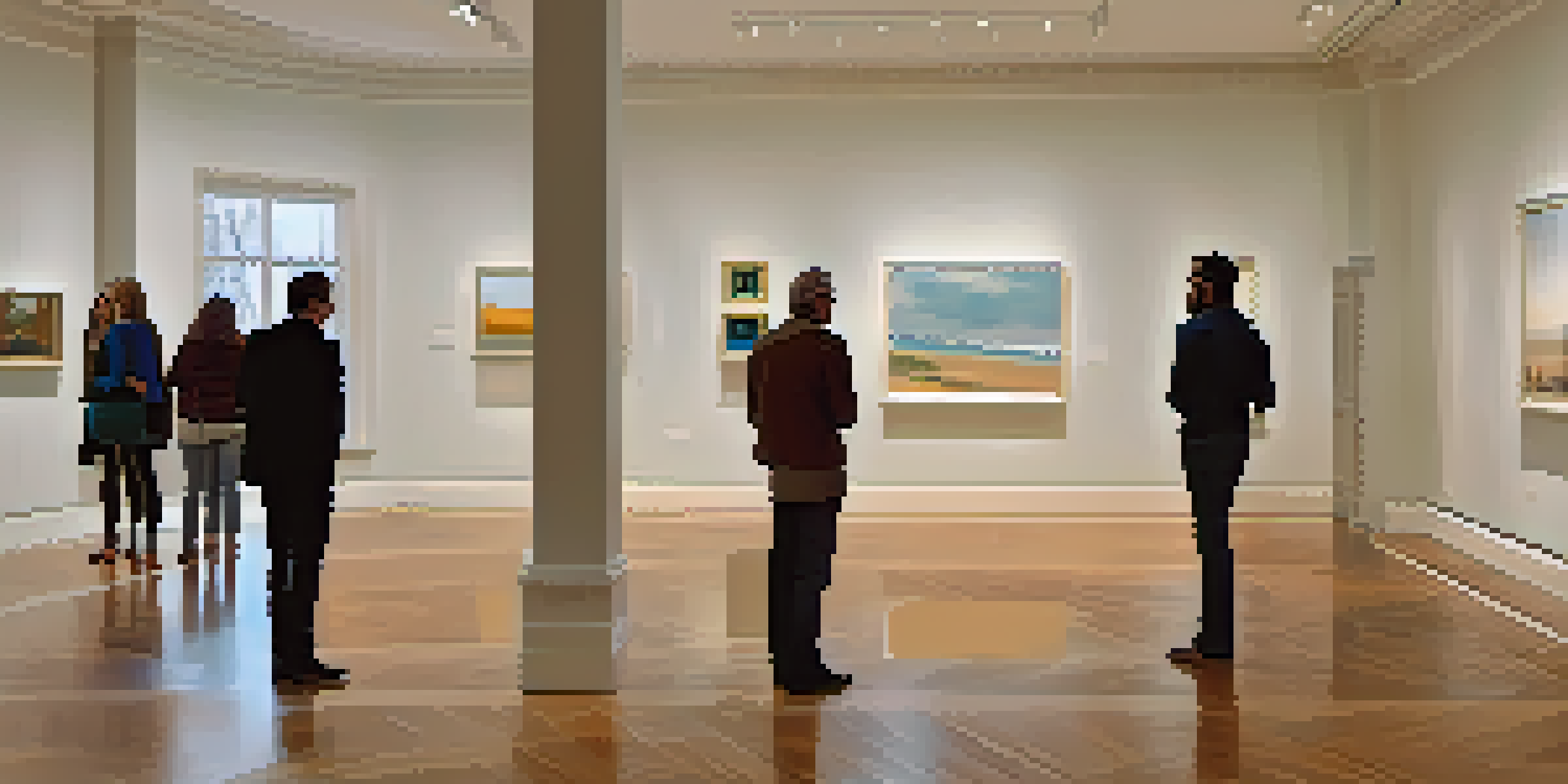The Art Market: Investing in Paintings and Sculptures

Understanding the Art Market Landscape
The art market is a vibrant and dynamic space where creativity meets commerce. It's a marketplace filled with a variety of artworks ranging from classic paintings to modern sculptures, each telling a unique story. Understanding this landscape is crucial for anyone looking to invest, as it involves not just financial investment but also an appreciation for the art itself.
Every artist dips his brush in his own soul, and paints his own nature into his pictures.
In recent years, art has increasingly been recognized as a viable investment option, often compared to traditional assets like stocks and real estate. With the rise of online platforms, accessing the art market has never been easier, allowing new investors to explore various styles and periods. However, navigating this market requires some knowledge about trends, auction houses, and artists to make informed decisions.
Moreover, the art market is influenced by cultural shifts, economic conditions, and even social media trends. By being aware of these factors, you can better predict which artists and styles are likely to appreciate over time. This understanding can pave the way for successful investments and a fulfilling experience.
Why Invest in Paintings and Sculptures?
Investing in paintings and sculptures offers more than just potential financial returns; it allows you to own pieces of culture and history. These artworks can serve as conversation starters in your home or office, often evoking emotions and memories. Plus, original pieces can provide a unique aesthetic that mass-produced items simply can't match.

Furthermore, art has historically shown resilience against market volatility. While stocks might fluctuate wildly, high-quality artworks often maintain or even increase their value over time. This stability can be appealing for investors looking for a hedge against inflation or economic downturns.
Art as a Unique Investment
Investing in art not only offers potential financial returns but also enriches your life with culture and history.
Additionally, the personal satisfaction derived from owning art can be immeasurable. Each piece is a reflection of your taste and values, making your collection distinctly yours. When you invest in art, you're not just acquiring an asset; you're enriching your life and potentially leaving a legacy for future generations.
Identifying Quality Art for Investment
When investing in art, quality is paramount. Look for pieces that exhibit strong craftsmanship, unique style, and have a compelling narrative. Researching an artist's background, their previous works, and their current market position can provide valuable insights into the quality of their art.
Art is the most beautiful of all lies.
One effective approach is to follow emerging artists, as they often represent a more affordable entry point. With proper research and an eye for talent, you might find a diamond in the rough whose value could skyrocket as they gain recognition. Attending galleries and art fairs can also expose you to fresh talent and allow you to engage with the art community.
Lastly, consider the provenance of a piece—its history of ownership. Art with a well-documented provenance often commands higher prices and is more likely to retain its value. This aspect can also add an intriguing story to your collection, making your investment even more meaningful.
Understanding Art Valuation Methods
Art valuation can seem complex, but understanding the basics can empower your investment decisions. Generally, artworks are valued based on factors like the artist's reputation, the artwork's age, its condition, and market demand. Appraisals by certified professionals can provide a formal valuation, which is essential for insurance and resale purposes.
Another method involves examining recent auction results. Auction houses publish sale prices for similar artworks, giving you a benchmark for understanding current market trends. By analyzing these results, you can gauge how much a piece might be worth and how its value might change over time.
Navigating Art Valuation
Understanding the factors that influence art valuation, such as artist reputation and market demand, is crucial for making informed investment decisions.
Additionally, consider the impact of rarity and uniqueness on valuation. Limited editions or one-of-a-kind pieces typically carry a premium price tag. Recognizing these nuances can help you make more informed choices when selecting art for your collection.
The Role of Auction Houses in Art Investment
Auction houses play a significant role in the art market, serving as platforms where artworks are bought and sold. They facilitate high-profile auctions that can set market trends and prices, making them a vital resource for investors. Familiarizing yourself with major auction houses like Sotheby's and Christie's can enhance your understanding of the market.
Participating in auctions can be exhilarating, with the thrill of bidding adding an extra layer of excitement. However, it's essential to do your homework beforehand—setting a budget, researching the artwork, and understanding the auction process can help you avoid impulsive decisions. Many auction houses also offer previews, where potential buyers can inspect artworks before bidding.
Moreover, auction houses provide valuable insights into the market with their reports and analyses. By keeping an eye on their sales data and trends, you can better position yourself within the art investment landscape. This knowledge can prepare you for future opportunities and help you make strategic investments.
The Impact of Online Platforms on Art Investment
The rise of online platforms has revolutionized the art market, making it more accessible than ever. Websites like Artsy and Saatchi Art allow you to browse and purchase artworks from the comfort of your home, opening up a world of possibilities for investors. This accessibility has also led to a democratization of art, where emerging artists can showcase their work without traditional barriers.
In addition to convenience, online platforms often provide detailed information about each artwork, including artist backgrounds and market trends. This wealth of information can help you make informed choices, whether you're a seasoned investor or a newcomer. Online marketplaces also host virtual auctions, allowing you to participate in bidding wars from anywhere.
Care for Your Art Collection
Proper maintenance and documentation of your art collection are essential to preserving its value and ensuring its longevity.
However, while online platforms offer many advantages, it's crucial to approach them with a discerning eye. The sheer volume of art available can be overwhelming, making it easy to fall for flashy marketing without fully understanding the artwork's value. Conduct thorough research and consider seeking advice from knowledgeable sources to navigate this digital art landscape effectively.
Maintaining and Caring for Your Art Collection
Once you've invested in art, proper care and maintenance are essential to preserving the value of your collection. This includes ensuring that artworks are displayed in suitable environments, free from direct sunlight, humidity, and extreme temperatures. Taking these precautions can help prevent damage and maintain the integrity of the pieces.
Regular cleaning and maintenance are also important. For paintings, using a soft, dry cloth can help remove dust without damaging the surface. Sculptures may require different cleaning methods depending on the materials used, so it's wise to consult experts if you're unsure.

Lastly, consider documenting your collection, keeping records of purchase prices, appraisals, and any conservation work done. This documentation can be invaluable for insurance purposes and future resale. By treating your art collection with care, you not only protect your investment but also ensure that each piece continues to bring joy for years to come.